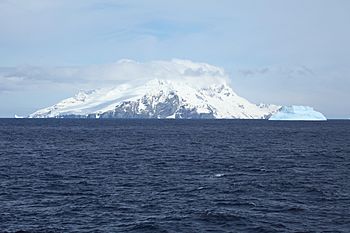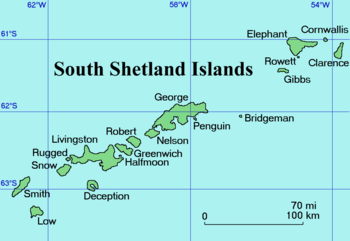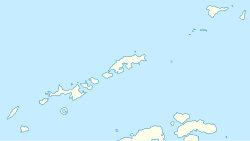Clarence Island (South Shetland Islands) facts for kids

Clarence Island seen from the north, with Cape Lloyd and Jubilee Peak in the foreground
|
|

Location of Clarence Island
|
|
| Geography | |
|---|---|
| Location | Antarctica |
| Coordinates | 61°12′S 054°05′W / 61.200°S 54.083°W |
| Archipelago | South Shetland Islands |
| Length | 21.46 km (13.335 mi) |
| Highest elevation | 1,950 m (6,400 ft) |
| Highest point | Mount Irving |
| Administration | |
| Administered under the Antarctic Treaty System | |
| Demographics | |
| Population | 0 |
Clarence Island is the easternmost island in the South Shetland Islands, off the coast of Antarctica. It is claimed by Argentina as part of Argentine Antarctica, by Britain as part of the British Antarctic Territory, and by Chile as part of the Chilean Antarctic Territory. The name dates back to at least 1821 and is now established in international usage.
The island is 21.46 km (13.3 mi) long and oriented in a south-southwest to north-northeast direction. Ravelin Ridge and Urda Ridge occupy the interior of the mountainous island. The summit Mount Irving, 1,950 meters (6,398 ft) high, rises 6.675 km (4.148 mi) north of Cape Bowles, the southernmost point. The southeast slopes of the two ridges are drained by Dobrodan, Highton, Treskavets, Orcho, and Banari Glaciers, and their northwest slopes — by Skaplizo, Giridava, and Bersame Glaciers. There are two small islands just east of Clarence Island, the northern one is named Sugarloaf Island. Chinstrap Cove lies on the northwest coast of the island, while Istros Bay, Smith Cove, and Kutela Cove lie on its southeast side.
Antarctic explorer Ernest Shackleton's Imperial Trans-Antarctic Expedition observed and considered landing on Clarence Island after escaping the pack ice of the Weddell Sea but instead landed on nearby Elephant Island. The high point on Clarence Island was reached by members of the Joint Services Elephant Island Expedition in 1970, which also completed a survey of Elephant and Clarence Island.
Maps
See also
 In Spanish: Isla Clarence (Antártida) para niños
In Spanish: Isla Clarence (Antártida) para niños



